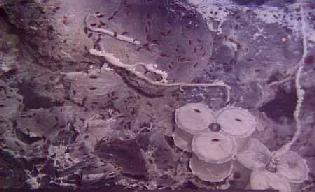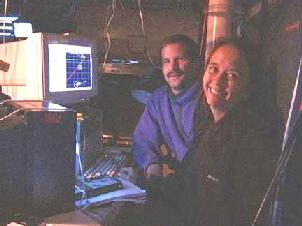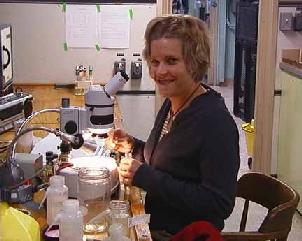WHAT'S NEW:
BACKGROUND:
Mission
Project Description
Cruise Plans:
Participants
Technology (ROV, ships, etc.)
Future Plans
Results:
1998 NeMO Cruise
Axial 1998 "Eruption"
Logbook
June 28, 1999
June 28, 1999
Contents:
- News from Thompson
- News from Wecoma
- Participant Perspective
- Logbook from Teacher at Sea
- Question/Answer from shore to sea
Thompson Science Report
Science Report - Monday, June 28
Ships Location: 45 51.1/129 54.1

Photo from dive 488 of Cloud Vent area. Pictured are bacterial traps amongst a new species of scale worms. |
Wecoma Science Report
See Wecoma's Teacher Log for information.
Listing of all Science News postings
Life at Sea: Participant Perspective
Dave Butterfield
NOAA Vents Program/University of Washington
 Hello, my name
is Dave Butterfield, I'm an oceanographer with the University
of Washington, and I work with the NOAA
VENTS Program in Seattle. I've been studying submarine volcanoes and
hydrothermal fluid chemistry since my graduate student days beginning in
1984. My research in the last few years has focused on how the submarine
hot springs change over time after volcanic activity on the seafloor, and
also on the connection between the microbial communities that live below
the seafloor and the composition of the fluids. That link between chemistry
and biology is a big part of our work out here this year for NEMO.
Hello, my name
is Dave Butterfield, I'm an oceanographer with the University
of Washington, and I work with the NOAA
VENTS Program in Seattle. I've been studying submarine volcanoes and
hydrothermal fluid chemistry since my graduate student days beginning in
1984. My research in the last few years has focused on how the submarine
hot springs change over time after volcanic activity on the seafloor, and
also on the connection between the microbial communities that live below
the seafloor and the composition of the fluids. That link between chemistry
and biology is a big part of our work out here this year for NEMO.
Our early dives on ROPOS this year have yielded some great samples for our chemistry-microbiology work (in collaboration with colleagues from the University of Washington, Western Washington University, and the University of Montreal). Some of the vents that we sampled last year have nearly died out, but others have heated up, and more vent animals have colonized some of the sites. One of the most spectacular finds occurred at the end of a 20-hour dive yesterday. We were investigating a line of vents that last year all had a similar appearance of whitish vent fluid, hence the names: Milky, Ouzo, and Magnesia. The first two sites along this line of vents were nearly dead and covered with orange, iron-rich mats. The next site showed faint signs of venting, and then we found a very active "snowblower" vent that was venting clouds of whitish fluid with flocs of white material in it. As we sat in front of this vent, taking as many fluid and particle samples as we could, one person after another in the noisy, crowded control room was heard to say, "hey, that looks just like one of those liquid-filled toy scenes with plastic snow that you shake up. "Snowblower"-type vents have been found at several sites after volcanic eruptions (click for video of a snowblower site at CoAxial seismic site), and the processes producing them are still being debated. We're hoping to learn something from our samples.
I feel lucky to be able to do oceanographic research as a career. The science is a lot of fun, as new questions are always coming up, and it challenges one's energy and creativity to come up with answers. I think people who stay scientists fall in love with this process of solving little mysteries, or, ever so seldom, a big one.
The scientific aspect of oceanography is not unlike any other discipline: we gather and analyze data to develop and test hypotheses about how things work. But, the culture of going to sea sets oceanographers apart. Most of us live with fairly predictable daily and weekly routines on land (working hours, weekends, household maintenance). There's an even tighter clockwork for how ships are run (many of the crew work specified four-hour watches twice a day, and there are set meal times). But when you get on a research ship to do the kind of scientific research we are doing out on this NEMO cruise, you say goodbye to your life on land and throw away all routine. It's an intense experience, to be in a confined space out on the ocean, focused on a project and the tasks that need to be completed. Living and working with your colleagues for a month, nonstop, you get to know people in a way that just doesn't happen in an office environment. This experience stays with you. I'm glad to have had it.
And going home is always sweet.
Listing of all Perspectives postings
Teacher At Sea Logbook
Day 13, Monday 6/28/99
The Wecoma is cruising rapidly for its homeport at 12.5 knots. When we reach homeport we will have travelled 1275 miles. The scientists are busy deconstructing their equipment from the laboratory on the ship that has been an effective working area for our two-week cruise. The final reports are being entered into the computer. Everyone has the look of wanting to get home. I too look forward to flying back to Los Angeles tomorrow, but ... it is almost as if summer camp is over. I know I will not see the new friends I have made aboard this vessel for some time. Most of the scientists are based in Seattle at PMEL/NOAA. They will be working on the analysis of the collected samples for a long time at their NOAA/PMEL laboratories.
The opportunity to investigate hydrothermal activity at Axial Volcano on the Juan de Fuca Ridge has been educational and rewarding. I will use the knowledge gained with my students at Stephen Foster Elementary and share with others as well. I am glad you joined us on the NeMO site and I hope you will follow the study that Dr. Ed Baker and fellow scientists continue enthusiastically.
Fair seas ... sail on in
education,
Ms Deck
Thompson Teacher at Sea Log Teacher at Sea Log #8 6/28/99
It was a far different day today then we had yesterday. Even ROPOS is taking the day off. Technicians are working diligently to get rid of the glitch (hydraulic problem) that has continued to cause us frustration. So with our trusty ROV on the deck and the boat tossing and turning due to heavier winds (15 - 20 knots) and seas (5 - 10 ft swells), the goals for today are transponder calibration and some biological lab work.
As I mentioned in an earlier report, while ROPOS is in the water, it
is important to know where it is in relation to the vent site, ship and
its cage. In order to accomplish this, the dive site needs preparing.
This is accomplished using transponders. On vent sites that are visited
most often, more permanent transponders are placed that can stay deployed
for about 5 years. For those sites visited less often, temporary transponders
are deployed. They will be recovered after that site has been studied.
In order to trust the data gathered from the transponders, calibrations
need to be made and that takes time. To do this, our navigation specialists,
Bill Chadwick
along with Susan
Merle, Paul Johnson and Maia Tsurumi, lower a rather odd looking instrument over the side. "El
Guapo" (which means the handsome one), is a train wheel with a communication
device attached to it. (photo right) With this device suspended some 35
m below the ship, sound signals radiate out from it at a specific frequency.
When that sound reaches the transponders, that frequency triggers a response
and the transponders send signals back. Based on the frequency and time
it takes for the reply, the computer on board is able to get a better
location set for each one. The ship moves about the area where the transponders
have been dropped, collecting the data points needed for an accurate fix
for all transponders placed. The locations they were dropped in could
be used for their fixed positions but they are inaccurate. Any given GPS
(latitude and longitude)  position can be off by as much as 100 m. With ROPOS' time on the bottom
being so valuable, the less time it takes to search for the vent site
the better. So scientists (photo left) must calibrate the transponders
by driving the ship around the area and "fixing" the best GPS positions
of the instruments relative to the positions apart on the seafloor. It
is worth the extra preparation time in order to maximize the time on the
bottom used for exploration, sample gathering, and actual studying of
the vents themselves.
position can be off by as much as 100 m. With ROPOS' time on the bottom
being so valuable, the less time it takes to search for the vent site
the better. So scientists (photo left) must calibrate the transponders
by driving the ship around the area and "fixing" the best GPS positions
of the instruments relative to the positions apart on the seafloor. It
is worth the extra preparation time in order to maximize the time on the
bottom used for exploration, sample gathering, and actual studying of
the vents themselves.
In the biology lab on board, high temperature microbiology samples
that were collected are being maintained for further studies. One way is
to quick freeze the sample using liquid nitrogen. In order to maintain a
 live sample in culture, the microbes are incubated at high temperature in
a variety of media. (photo right of
Jean Marcus examining samples) These ship board conditions are meant to simulate
what scientist imagine the subsurface seafloor environment may be like in
hydrothemal systems. The scientists bring with them a variety of nutrient
rich media that they believe the microbes will survive and replicate in.
Maintaining these cultures as live specimens enables the researchers to do
some preliminary tests like seeing what temperature they grow best at or
the extreme temperature levels they can exist in. The real importance of
culturing is to create a sample containing an abundant supply of the
microbes to work with back on land.
live sample in culture, the microbes are incubated at high temperature in
a variety of media. (photo right of
Jean Marcus examining samples) These ship board conditions are meant to simulate
what scientist imagine the subsurface seafloor environment may be like in
hydrothemal systems. The scientists bring with them a variety of nutrient
rich media that they believe the microbes will survive and replicate in.
Maintaining these cultures as live specimens enables the researchers to do
some preliminary tests like seeing what temperature they grow best at or
the extreme temperature levels they can exist in. The real importance of
culturing is to create a sample containing an abundant supply of the
microbes to work with back on land.
I learned a valuable lesson today about ships in rough weather. Be careful of where you stand. The rain that settles on the top decks seeks a path to the lower decks whenever the ship's bow is raised due to a swell. That water will find a stair well or walkway edge, and if you're the unlucky person standing under it, you get a cold shower. Lastly, the honey bear saga continues. It was last seen making deep-sea dives as a guest rock corer. We'll stay after this story.
Bye for now.
Logbook of all Teacher At Sea postings
Questions & Answers
(oar.pmel.vents.webmaster@noaa.gov)